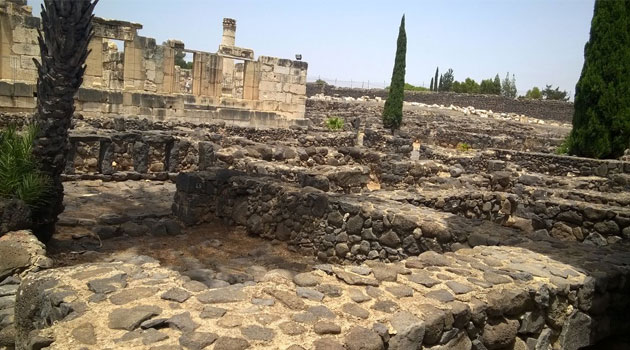
Remains of the town of Capernaum where Jesus lived for three years during his ministry. It includes the late fourth Century A.D ‘White Synagogue’ built on the remains of the Synagogue of Jesus. Photo/ MARGARET WAHITO
NAIROBI, Kenya, Jun 16 – Imagine going to the land where the one who gave the world its biggest religion yet was born. Imagine going to the garden where Jesus prayed, going to the Sea where he walked on water; imagine standing on the footpath where he is believed to have ascended into heaven.
I, like the millions of Christians around the world, went to Israel to trace where it all began.
It was my debut visit to Israel which lies on about 20,000 square kilometres, and the best explanation of my experience during my eight-day stay in the ‘Holy Land’ is that it was magical.
From the religious historic sites, to the cities, the hospitality of the people and their culture, to agricultural projects, museums, name them.
Some of the famous areas I managed to visit include the city of Jerusalem where I spent my first three nights, Mount of Olives where it is believed Jesus ascended to heaven, the Wilderness of Judea where he fasted for 40 days, the Dead Sea which is the lowest place on earth above ground, the Old City of Jerusalem and the Jordan River where Jesus was baptized.
There was the Sea of Galilee famous for Jesus walking on water, Cana of Galilee where he performed his first miracle, Capernaum where he lived for three years and Bethlehem where Jesus was born, a city now under Palestinian authorities.
I cannot also forget the Garden tomb which is one of the archaeological sites where Christians believe Jesus’ body stayed for three days before resurrecting. And the list is endless.
I could not also help but marvel at Israel’s success in agriculture, despite being on rocky and desert land, their unique Jewish communities known as Kibbutz where members with a common purpose of practicing equality live together with set rules.
There is also the high technology being applied in numerous sectors including managing of municipalities, traffic, hospitals and even agriculture.
Despite my sole purpose for the Israel visit being pilgrimage, the government has managed to classify her tourism so well that by the time I get back home I have a different narrative apart from the pilgrimage and of course away from negative news on Israel and the Gaza strip.
Travel agencies and tour guides have also perfected the art, so as to add value to the pilgrims.
According to our Kenyan Ambassador in Israel Lt General (Rtd) Augostino Njoroge, all these trickles down to proper packaging. Kenya may never be a religious historic site like Israel to attract close to over 3.5million tourists annually, but has room to change the gear and reform its tourism sector and attract even more.
“You may be presented with food and you feel like not eating it. But when you taste, you realise the food is very sweet. On the other hand, one can give you the same good food in another better way and you feel like having it immediately. The difference? Presentation,” says Njoroge when I pay a courtesy call at the Kenyan Embassy based in Tel Aviv.
Njoroge argues that it was high time for Kenya to diversify its mode of marketing apart from the famous Safari and the beaches, and get other unique sites preached out there.
“In Kenya, we have a lot of tourist sites like conservancies, that if well packaged, could earn the country billions of dollars. At the moment, its only school children taken there,” he laments.
But above all, another big tourist attraction that is not often spoken about is the Kenyan people and their diverse unique cultures.
“For example we can have some tourists live with a Maasai family or Kikuyu family for five days and experience how they live, trust me, even if they visit the parks and other places, they are likely to remember those five days more,” he says.
He also emphasizes on the need for the government to support Kenya Airways so as to have direct flights to Israel. This, he says would boost the number of tourist coming to Kenya from Israel. At the moment we have on less than 4,000 tourists from Israel coming to Kenya.
Danny Amir, Managing Director Vered Hasharon, an international tours and travel firm based in Israel, echoes the issue of direct flight to Kenya from Israel adding that there was room for Kenya to attract thousands of tourists from Israel who are still not aware about Africa.
“Most of the people here who visited Kenya and Africa say it was like 20 years ago. You don’t expect them to give the true picture of the current Kenya and Africa as a whole. We have tens of thousands of young people who are graduating from the army ever year and when given options for holidays, very few or none talk about Africa, yet is has the best destinations. Kenya should tap on this,” he urges.
In 2014, total revenue from tourism in Israel is estimated at about $10.6billion (Sh271.5billion) compared to Kenya’s, which stood at Sh87.1billion. Long way to go.



































